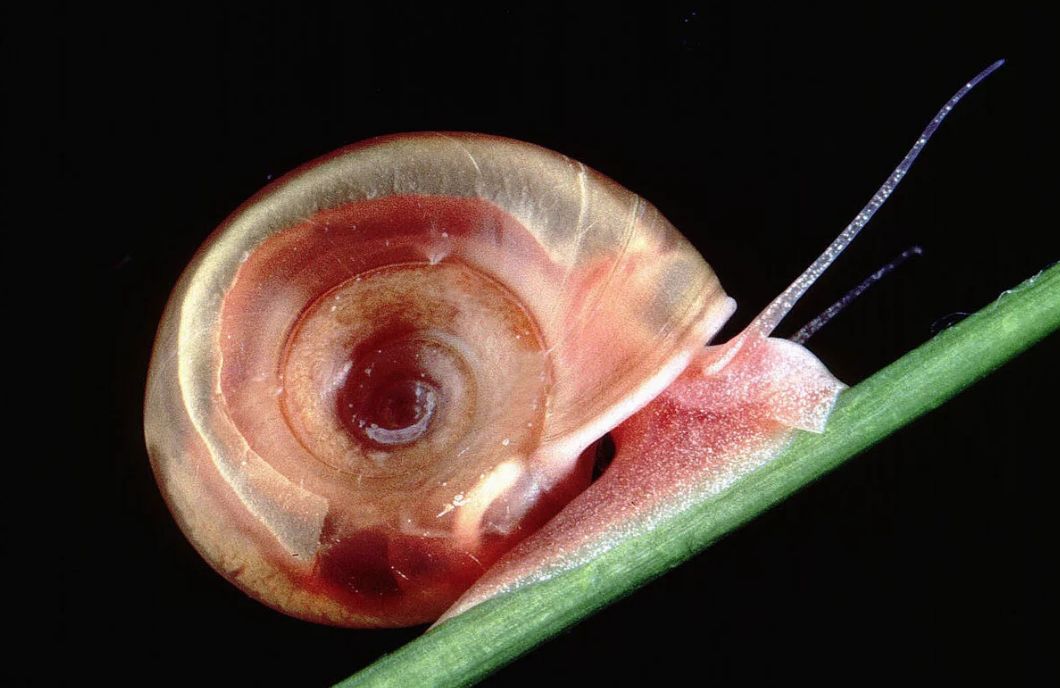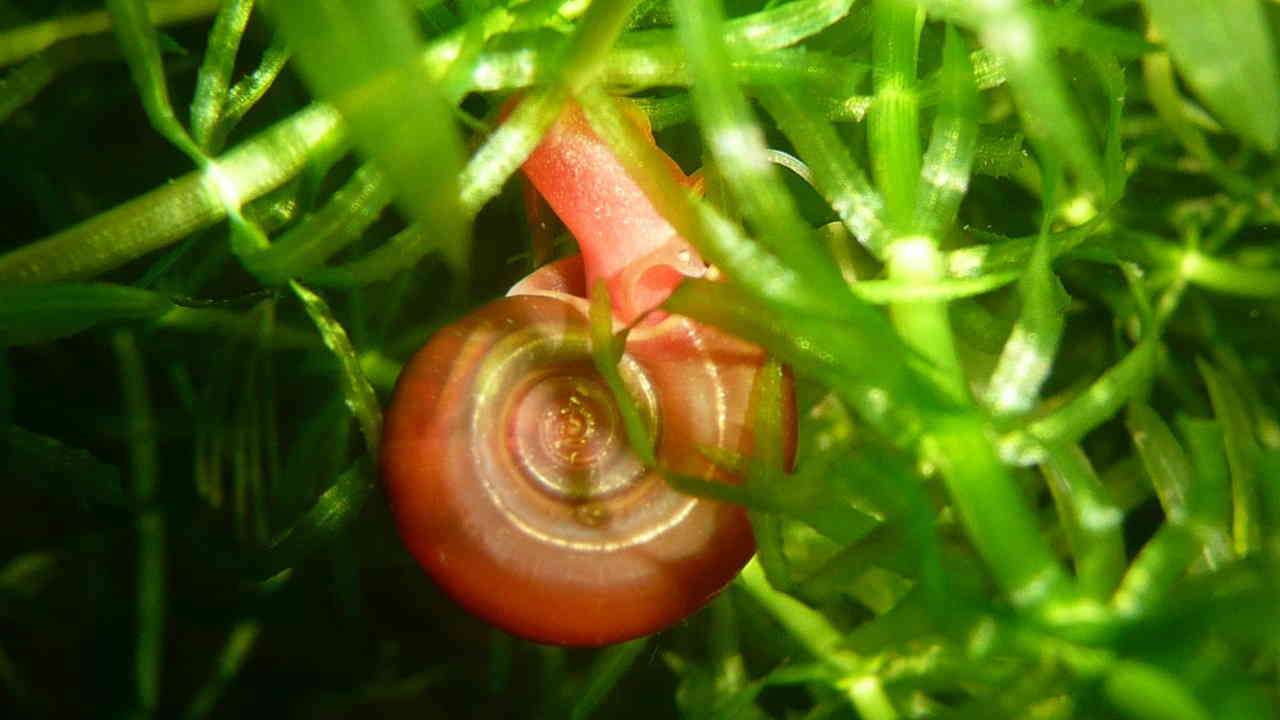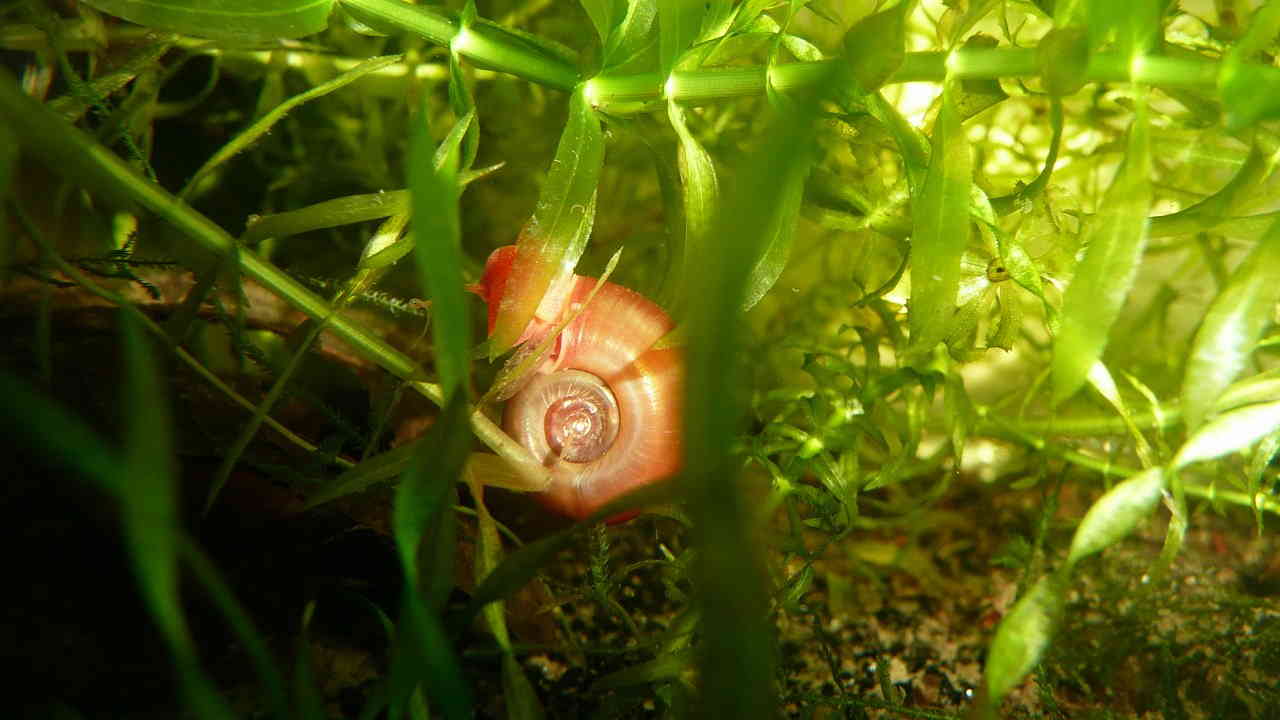Ramshorn snails are a fascinating addition to any freshwater tank, known for their distinctive spiral shells that resemble ram horns. These snails belong to the Planorbidae family and play a vital role in maintaining a healthy aquarium ecosystem.
They are excellent scavengers, feeding on algae and uneaten food that could otherwise harm fish health. This natural cleaning process helps keep the tank tidy and reduces the risk of water quality issues.
Additionally, ramshorn snails serve as indicators of tank health. If you notice them climbing from the bottom to the water surface, it’s a signal that something may be off with the water quality, prompting you to consider a water change. Including ramshorn snails in your aquarium not only enhances its beauty but also contributes to a healthier environment for your aquatic life.

Contents
Habitat in the wild
Ramshorn snails are found all over the world, with a wide distribution across North America, Europe, Asia, and parts of Africa. These adaptable creatures thrive in various freshwater ecosystems, particularly in shallow waters with slow flow or stagnant conditions.
They often inhabit areas rich in decaying plant matter, which provides both shelter and food. In their natural environments, ramshorn snails are vital to the balance of the ecosystem. As detritivores, they feed on decomposing plant material, algae, and organic debris, playing a crucial role in breaking down and recycling nutrients.
These snails have adapted to low-oxygen conditions and can breathe atmospheric air, which allows them to survive in habitats where oxygen levels may fluctuate. In rivers, they tend to be found in densely planted backwaters, as they struggle to thrive in areas with strong currents.
While ramshorn snails can be beneficial to their native ecosystems, they can also become invasive when introduced to new environments. In such cases, they may outcompete local snail species, disrupting the balance of the ecosystem. Understanding their dual role helps us appreciate their importance and the potential challenges they pose when placed outside their natural range.

Description
In a planted tank, ramshorn snails can display a range of colors, including red, brown, and even blue. The blue variety is particularly interesting, as it results from selective breeding of snails with pigment-free shells and those with dark brown bodies. This breeding method allows the light to shine through the shell, creating the appearance of blue. However, it’s important to note that blue ramshorn snails can produce offspring with standard coloration, with about 20% of their young displaying the typical colors.
To maintain the unique blue coloring, it’s advisable to selectively remove any ordinary-colored snails from the tank.
Ramshorn snails have a flat, voluted shell, with an elongated, cone-shaped body that matches the shell color. They move using a wide, flat foot, which is visible outside the shell. The snails also possess long, thin tentacles on their heads, with eyes located at the base of these tentacles.
These snails are amphipneustic, meaning they can thrive in low-oxygen waters. They breathe atmospheric air through a specialized pulmonary cavity and can also absorb dissolved oxygen from the water.
One fascinating behavior of ramshorn snails is their ability to swim at the water’s surface with their shells turned downward. They achieve this by adjusting their buoyancy, taking in additional air to help them float. When disturbed, they release this air and may sink as a defense mechanism against predators.
| Characteristic | Description |
|---|---|
| Family | Planorbidae |
| Size | 1/4 inch to 1 inch (0.6 cm to 2.5 cm) in shell diameter |
| Shell Shape | Coiled spiral |
| Shell Color | Varies (brown, red, translucent) |
| Body Structure | Soft, elongated body with a muscular foot |
| Lifespan | Typically 1 to 2 years |
| Habitat | Freshwater habitats such as ponds, lakes, and slow streams |
| Feeding Behavior | Herbivorous, feeding on decaying plant matter and algae |
| Reproduction | Hermaphroditic, laying eggs in clusters or gelatinous masses |
| Environmental Tolerance | Adaptable to a range of water conditions |
| Predators | Fish, turtles, water birds, and some invertebrates |
| Ecological Role | Helps in nutrient cycling, algae control, and detritus removal |
| Benefits in Aquariums | Cleans up organic debris, contributes to a balanced ecosystem |

Breeding
Ramshorn snails are fascinating hermaphrodites, meaning a single snail can reproduce on its own through self-fertilization. When they are ready to mate, they engage in a process known as reciprocal mating, where two snails may exchange genetic material. After mating, they lay eggs on various surfaces within the tank, such as the walls and leaves of plants.
The egg clutches appear as transparent nodes containing tiny, barely visible round cells. These translucent eggs take several days to hatch, typically within a week or more, depending on the environmental conditions. Each egg houses a small snail that will emerge after about 4 to 14 days, ready to begin its own life.
Once hatched, juvenile ramshorn snails closely resemble miniature adults. They will gradually grow and develop their shells as they consume food and nutrients available in the aquarium. Providing proper nutrition and maintaining suitable water parameters are crucial for their healthy development.
Egg-Laying Frequency
Ramshorn snails have the remarkable ability to continuously lay eggs throughout their reproductive lifespan. The intervals between egg-laying events can vary; some snails may produce eggs every few days, while others might lay eggs every couple of weeks. Individual snails may experience shorter or longer intervals, depending on their conditions and environment.
Care and keeping in a tank
While ramshorn snails can receive negative feedback due to their ability to breed rapidly and potentially overpopulate a tank, this typically occurs only when tank owners overfeed their fish or when the snails lack natural predators.
Do Ramshorn Snails Eat Plants?
A common misconception is that ramshorn snails feed on live plants. In reality, they do not damage healthy plants. This misunderstanding arises when people observe snails on the leaves of decaying or dead plants. The snails are not the cause of the plant’s deterioration; instead, they are consuming the decomposing material. Ramshorn snails have relatively weak teeth that prevent them from making holes in healthy plants, but they will readily eat rotting plant matter.
Additionally, ramshorn snails are known to occasionally climb above the waterline to explore. To prevent escapes and ensure their safety, it’s essential to provide adequate vertical space and a securely fitted lid for the aquarium. By understanding their habits and needs, aquarists can maintain a balanced and thriving environment for these fascinating snails.
Water parameters
For the health and well-being of ramshorn snails, maintaining optimal water parameters is crucial. These snails can tolerate a wide range of water temperatures, but they thrive best within a specific range. The recommended water temperature for ramshorn snails is between 75°F (24°C) and 81°F (27°C). Within this range, they are more active, exhibit normal feeding behaviors, and achieve optimal growth. While they can endure slightly higher or lower temperatures, extreme fluctuations can stress or harm them.
In addition to temperature, pH levels are important for their health. Ramshorn snails prefer a slightly alkaline to neutral environment, with an ideal pH range of 7.0 to 8.0. While they can tolerate a broader pH spectrum, it is best to avoid extreme fluctuations or highly acidic conditions.
Regarding water hardness, ramshorn snails adapt well to varying levels but generally prefer slightly harder water with moderate to high mineral content. A good guideline is to maintain a hardness level of 6 to 12 dGH (degrees of general hardness). By keeping these parameters in check, aquarium owners can create a thriving environment for their ramshorn snails.
Tank size
The suitable size depends on the number of snails you plan to keep and the overall setup of your aquarium. Ramshorn snails are relatively small and can adapt to various tank sizes, but providing adequate space is crucial.
For a small group of up to 5 to 10 ramshorn snails, a tank of around 5 gallons (19 liters) can be sufficient. This allows them enough room to move around and explore their environment. However, if you plan to maintain a larger population, it’s advisable to provide a bigger tank. As a general guideline, aim for a minimum tank size of 10 gallons (38 liters) for a moderate-sized group. By ensuring ample space, you can help your ramshorn snails thrive in a healthy and active environment.
Feeding
Ramshorn snails have a diverse diet and can feed on a variety of foods, including vegetables, decaying plants, fish food, and even dead fish. To ensure they receive a balanced diet, you can supplement their meals with boiled vegetables such as lettuce, cucumbers, squashes, and cabbage. It’s important to boil these vegetables for about a minute and then cut them into small pieces before offering them to the snails. This approach helps provide essential nutrients while ensuring the food is safe and easily consumable for your snails.
Tank mates
Ramshorn snails are completely peaceful and coexist well with their tank mates, including fish and shrimp. They are scavengers and may feed on dead fish, which can sometimes lead to misconceptions that the snails are responsible for the deaths. However, if a ramshorn snail colony becomes overpopulated, certain fish, such as clown loaches, pea puffers, or paradise fish, may prey on them.
Here are some common tank mates that can generally coexist peacefully with ramshorn snails:
- Community fish species such as neon tetras, guppies, mollies, and rasboras.
- Small, peaceful shrimp species like cherry shrimp or amano shrimp.
- Snail species that have similar care requirements, such as nerite snails or Malaysian trumpet snails.
- Peaceful bottom-dwelling fish like Corydoras catfish or otocinclus catfish.